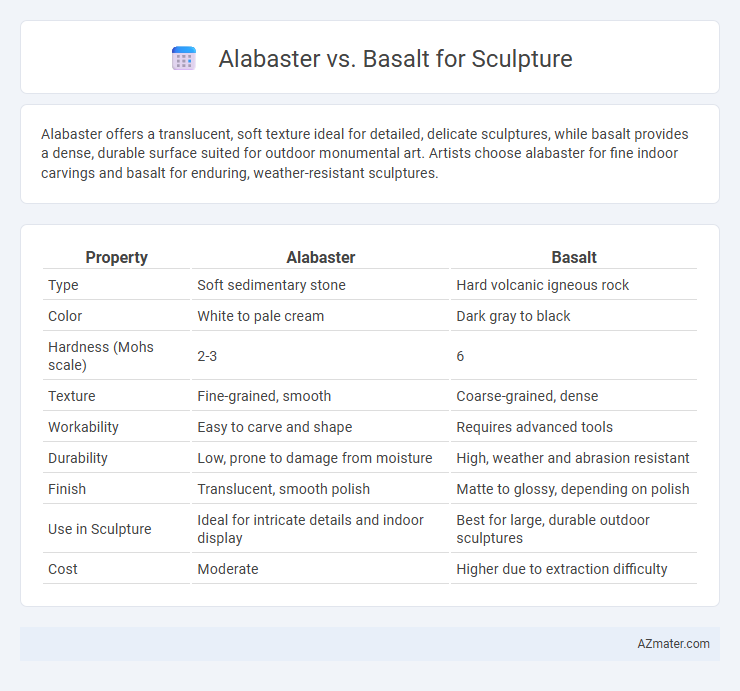Alabaster offers a translucent, soft texture ideal for detailed, delicate sculptures, while basalt provides a dense, durable surface suited for outdoor monumental art. Artists choose alabaster for fine indoor carvings and basalt for enduring, weather-resistant sculptures.
Table of Comparison
| Property | Alabaster | Basalt |
|---|---|---|
| Type | Soft sedimentary stone | Hard volcanic igneous rock |
| Color | White to pale cream | Dark gray to black |
| Hardness (Mohs scale) | 2-3 | 6 |
| Texture | Fine-grained, smooth | Coarse-grained, dense |
| Workability | Easy to carve and shape | Requires advanced tools |
| Durability | Low, prone to damage from moisture | High, weather and abrasion resistant |
| Finish | Translucent, smooth polish | Matte to glossy, depending on polish |
| Use in Sculpture | Ideal for intricate details and indoor display | Best for large, durable outdoor sculptures |
| Cost | Moderate | Higher due to extraction difficulty |
Introduction to Alabaster and Basalt
Alabaster, a soft, translucent stone primarily composed of gypsum or calcite, is favored for its smooth texture and ease of carving, making it ideal for detailed sculptures and fine art pieces. Basalt, an igneous volcanic rock, is significantly harder and denser, offering durability and a distinctive dark gray to black coloration that provides a striking, modern aesthetic for outdoor and large-scale sculptures. Artists often choose alabaster for intricate indoor works due to its softness, while basalt's robustness makes it suitable for enduring, monumental sculptures exposed to the elements.
Geological Origins and Composition
Alabaster, a fine-grained gypsum or calcite mineral, forms through the evaporation of ancient seawater or groundwater, resulting in its soft, translucent texture ideal for detailed sculpting. In contrast, basalt is a dense, fine-grained igneous rock originating from the rapid cooling of basaltic lava at the Earth's surface, characterized by its durability and dark color. The mineralogical differences--alabaster's gypsum or calcite composition versus basalt's mafic minerals (plagioclase, pyroxene, and olivine)--influence their workability and visual appeal in sculpture.
Physical Properties Comparison
Alabaster is a soft, translucent stone with a Mohs hardness of 2-3, making it easy to carve detailed sculptures but prone to scratching and damage. Basalt, with a hardness of 6, is significantly harder and denser, providing durability and resistance to weathering, ideal for outdoor monuments. The fine-grained texture of basalt contrasts with alabaster's smooth, almost waxy surface, affecting the level of detail and finish achievable in sculptural work.
Workability and Carving Techniques
Alabaster offers superior workability for sculptors due to its softness and smooth texture, allowing for fine detailing with basic carving tools. Basalt, being a hard and dense volcanic rock, requires specialized tools like diamond-tipped chisels and rotary grinders, which makes the carving process more labor-intensive and suitable for creating bold, larger forms rather than intricate details. Artists often choose alabaster for delicate sculptures and basalts for durable, outdoor monuments because of these distinct carving techniques and material properties.
Aesthetic Qualities and Finishes
Alabaster offers a smooth, translucent aesthetic with soft, creamy tones that allow light to diffuse gently through the stone, creating a luminous, ethereal finish ideal for intricate, delicate sculpture details. Basalt, by contrast, features a dense, fine-grained texture with a rich, dark color palette that provides a bold, matte, or polished finish, emphasizing strong contrasts and contemporary, minimalist styles. The choice between alabaster and basalt significantly influences the sculpture's visual impact, with alabaster favoring light play and subtlety, while basalt highlights durability and stark elegance.
Durability and Longevity in Sculptures
Basalt offers superior durability and longevity compared to alabaster, making it ideal for outdoor sculptures exposed to harsh weather conditions due to its dense, volcanic composition. Alabaster, while prized for its translucency and ease of carving, is softer and more susceptible to erosion, moisture damage, and UV exposure, which limits its use primarily to indoor or protected environments. Sculptors often select basalt for long-lasting monuments and public art installations, whereas alabaster is preferred for detailed, delicate works meant to be preserved indoors.
Popular Uses in Art History
Alabaster has been favored for intricate carvings and detailed sculptures due to its soft, translucent quality that allows light to pass through, popular in ancient Egyptian and Renaissance art. Basalt, known for its hardness and durability, was commonly used in monumental sculptures and architectural elements in Mesopotamian and Mesoamerican cultures. The choice between alabaster and basalt in sculpture significantly influenced the style and longevity of artworks across different historical periods.
Cost and Availability Factors
Alabaster is generally more affordable and widely available for sculptors due to its softness and abundance in regions such as Egypt and Italy. Basalt, a dense volcanic rock, tends to be more expensive and less accessible, often sourced from specific volcanic areas like the Pacific Northwest. The cost disparity influences artists' material choice, with alabaster favored for budget-conscious projects and basalt prized for durability despite higher expenses.
Best Applications for Artists
Alabaster offers exceptional softness and translucency, making it ideal for fine, detailed sculptures and indoor decorative art where light interaction enhances the aesthetic. Basalt's hardness and durability suit outdoor monuments and large-scale sculptures requiring weather resistance and longevity. Artists seeking intricate carvings and a luminous finish prefer alabaster, while those prioritizing structural strength and modern, rugged textures choose basalt.
Choosing the Right Stone for Your Sculpture
Alabaster offers a soft, translucent texture ideal for intricate details and smooth finishes, making it perfect for indoor sculptures that emphasize delicate features. Basalt's dense, durable composition resists weathering and is suited for large, outdoor sculptures requiring longevity and rugged aesthetics. Selecting the right stone depends on the sculpture's location, desired surface texture, and durability requirements, with alabaster favored for fine detail and basalt chosen for strength and outdoor resilience.

Infographic: Alabaster vs Basalt for Sculpture
 azmater.com
azmater.com